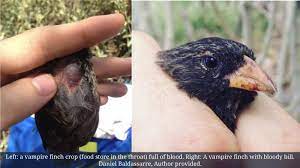Este interesante trabajo está enfocado en una especie de pinzón que se encuentra solo en las islas Darwin y Wolf, ubicadas en el extremo norte del archipiélago de Galápagos. Ambas islas son de muy difícil acceso incluso para los investigadores, ya que toda su costa es rocosa, lo cual dificulta el desembarque. Sin embargo, estas características han hecho de Darwin y Wolf un territorio interesante para la ciencia, pues, las especies que aquí habitan se han adaptado para sobrevivir.
Los pinzones de Darwin, como sabemos han ido adaptando la forma y tamaño de sus picos, lo que les ha permitido explotar diferentes alimentos. Por ejemplo, los picos largos y delgados permiten llegar al néctar de algunas flores, otros picos son mejores para triturar semillas o consumir insectos.
La pregunta es, ¿Por qué un pinzón evolucionó para alimentarse de sangre?, para Jaime Chaves, esta acción nace de un claro ejemplo de “mutualismo”, mecanismo mediante el cual, dos especies o más se benefician.
“Se sugiere que la acción de alimentarse de sangre se deriva de un comportamiento que es evidente en otros pinzones y en otras islas, que es el de alimentarse de parásitos externos en la piel de tortugas, iguanas, y en las plumas de aves como los piqueros. En el caso de los piqueros, estas aves tienen parásitos que viven en sus plumas y que se alimentan de la sangre y piel. Estos parásitos son retirados por los pinzones, por lo que este evento de mutualismo (pinzón se alimenta de parásitos – piquero se beneficia de esta limpieza) es común en las islas. Se cree que, en algunas ocasiones, estos parásitos (tipo de mosca) dejan cicatrices en la piel las cuales son aprovechadas por los pinzones para alimentarse de sangre” explicó Chaves
Además, se cree que la falta de fuentes de alimento en Darwin y Wolf,
sumado a que allí se encuentra una de las colonias más grandes de piqueros de
Nazca, puede explicar por qué los pinzones vampiro consumen sangre como parte
de su dieta, los pinzones incluso han aprendido a perforar la piel en la base de
las plumas jóvenes para acceder a la sangre directamente, sin necesidad de los
insectos parásitos.
Se estima que la sangre representa un pequeño porcentaje en la
alimentación de los pinzones vampiro, aproximadamente el 10% y aunque no
existen registros de muertes de piqueros por esta causa, es obvio que les
molesta, pero, son los pichones de piquero los que suelen estar más afectados,
así lo explica Jaime Chaves, “los pinzones también atacan a los pichones de
piqueros, y estos no puede volar y escapar de estos eventos de hematofagia. He
visto pichones caminando entre las rocas tratando de escapar de los pinzones, a
veces pueden caer y morir o perderse entre los matorrales y no volver al nido
donde son alimentados por los adultos”
Lo que
está claro es que la especie de pinzón vampiro de Wolf y Darwin solo habita en
estas islas, son suficientemente diferentes en su genética a las especies
hermanas que se encuentran en otras islas, además de poseer características del
pico diferentes. Por tanto, son consideradas especies únicas de estas dos
islas.






